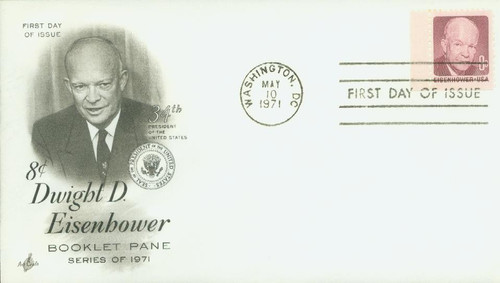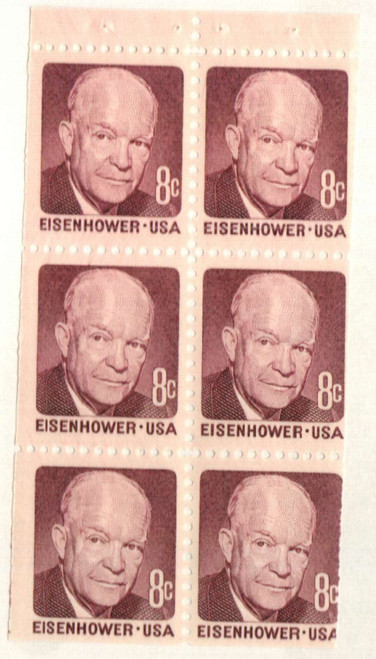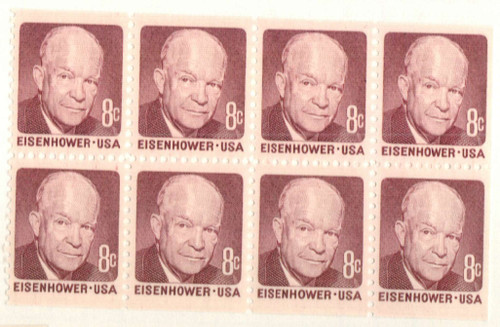
1972 8c Dwight Eisenhower booklet pane and label
# 1395c FDC - 1972 8c Dwight Eisenhower booklet pane and label
$2.00
U.S. #1395c
8¢ Dwight D. Eisenhower
Booklet Pane of 4
Booklet Pane of 4
Issue Date: May 10, 1971
City: Washington, DC
Printed By: Bureau of Engraving and Printing
Printing Method: Rotary Press
Perforations: 11 x 10 ½
Color: Black, red and blue gray
As General of the Army, Dwight D. Eisenhower led the Allied forces to a victory in Europe during World War II. A popular figure with the American people, he was elected as our 34th President.
Dwight D. Eisenhower (1890-1969)
34th United States President
Dwight David Eisenhower was born on October 14, 1890, in Denison, Texas. When Dwight was just a baby, his family moved to Abilene, Kansas. In 1911, two years after graduating from Abilene High School, Dwight was admitted to West Point. He graduated in 1915 and was assigned to Fort Sam Houston, in Texas.
During “war games” in 1941, Lieutenant Colonel Eisenhower commanded his forces to victory over General George Patton’s “enemy force.” This earned him the rank of brigadier general. In 1942, Eisenhower was promoted to major general, and within months became commanding general of U.S. forces in the European Theater of Operations. Over the previous two years, Eisenhower had advanced past 350 senior officers. By February 1943, Eisenhower was a four-star general.
When the decision was made to launch the largest seaborne invasion in military history, General Eisenhower was chosen as Supreme Commander of the Allied Expeditionary Force in Europe. On June 6, 1944, a multi-national force, commanded by Eisenhower, crossed the English Channel onto the beach in Normandy, France. By that evening, Allied forces controlled the beach.
Following the invasion, in December 1944, Eisenhower was promoted to five-star general, or General of the Army. In November of the following year, he became Army Chief of Staff.
Eisenhower successfully ran for the Presidency in 1952, under a ticket of “Modern Republicanism.” Eisenhower emphasized lower government spending and increased efficiency. Among the domestic proposals of his first term were the construction of the St. Lawrence Seaway and an interstate highway system, broadening of the Social Security System, and raising the minimum wage to $1 per hour.
President Eisenhower traveled to Korea to negotiate an end to the war. He ordered the CIA to take action against Communist governments around the world. Eisenhower proposed a program called Atoms For Peace, in which nations would donate atomic power to the United Nations. This program developed into the International Atomic Energy Agency.
President Eisenhower’s second term was even more eventful. In September, 1957, Arkansas Governor Orval E. Faubus defied a court order to integrate schools in Little Rock. President Eisenhower sent in the National Guard and the 101st Airborne Division to enforce the order. Also in 1957, the Soviet Union became the first nation in space when it launched Sputnik I, the world’s first artificial satellite.
In 1951, the 22nd Amendment came into effect, limiting Presidents to two terms. Unable to run for re-election in 1960, the President supported Vice President Richard Nixon. Following Nixon’s defeat, Eisenhower retired to his farm in Gettysburg, Pennsylvania. Eisenhower died of heart failure on March 28, 1969.
U.S. #1395c
8¢ Dwight D. Eisenhower
Booklet Pane of 4
Booklet Pane of 4
Issue Date: May 10, 1971
City: Washington, DC
Printed By: Bureau of Engraving and Printing
Printing Method: Rotary Press
Perforations: 11 x 10 ½
Color: Black, red and blue gray
As General of the Army, Dwight D. Eisenhower led the Allied forces to a victory in Europe during World War II. A popular figure with the American people, he was elected as our 34th President.
Dwight D. Eisenhower (1890-1969)
34th United States President
Dwight David Eisenhower was born on October 14, 1890, in Denison, Texas. When Dwight was just a baby, his family moved to Abilene, Kansas. In 1911, two years after graduating from Abilene High School, Dwight was admitted to West Point. He graduated in 1915 and was assigned to Fort Sam Houston, in Texas.
During “war games” in 1941, Lieutenant Colonel Eisenhower commanded his forces to victory over General George Patton’s “enemy force.” This earned him the rank of brigadier general. In 1942, Eisenhower was promoted to major general, and within months became commanding general of U.S. forces in the European Theater of Operations. Over the previous two years, Eisenhower had advanced past 350 senior officers. By February 1943, Eisenhower was a four-star general.
When the decision was made to launch the largest seaborne invasion in military history, General Eisenhower was chosen as Supreme Commander of the Allied Expeditionary Force in Europe. On June 6, 1944, a multi-national force, commanded by Eisenhower, crossed the English Channel onto the beach in Normandy, France. By that evening, Allied forces controlled the beach.
Following the invasion, in December 1944, Eisenhower was promoted to five-star general, or General of the Army. In November of the following year, he became Army Chief of Staff.
Eisenhower successfully ran for the Presidency in 1952, under a ticket of “Modern Republicanism.” Eisenhower emphasized lower government spending and increased efficiency. Among the domestic proposals of his first term were the construction of the St. Lawrence Seaway and an interstate highway system, broadening of the Social Security System, and raising the minimum wage to $1 per hour.
President Eisenhower traveled to Korea to negotiate an end to the war. He ordered the CIA to take action against Communist governments around the world. Eisenhower proposed a program called Atoms For Peace, in which nations would donate atomic power to the United Nations. This program developed into the International Atomic Energy Agency.
President Eisenhower’s second term was even more eventful. In September, 1957, Arkansas Governor Orval E. Faubus defied a court order to integrate schools in Little Rock. President Eisenhower sent in the National Guard and the 101st Airborne Division to enforce the order. Also in 1957, the Soviet Union became the first nation in space when it launched Sputnik I, the world’s first artificial satellite.
In 1951, the 22nd Amendment came into effect, limiting Presidents to two terms. Unable to run for re-election in 1960, the President supported Vice President Richard Nixon. Following Nixon’s defeat, Eisenhower retired to his farm in Gettysburg, Pennsylvania. Eisenhower died of heart failure on March 28, 1969.











